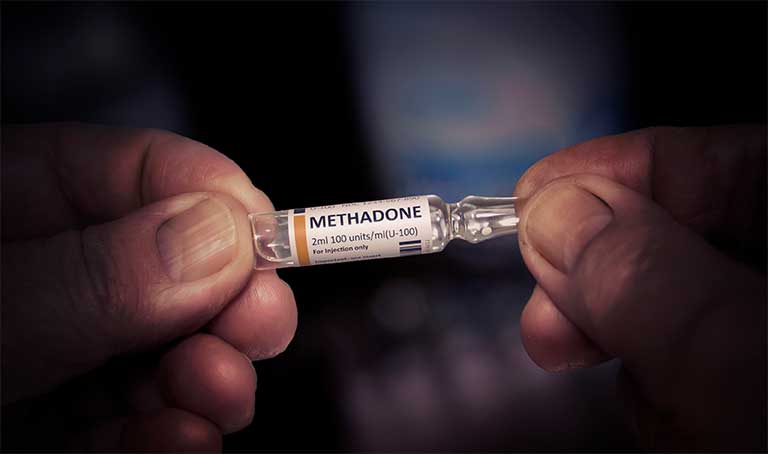Methadone Dosage | Initial, Adjusted, & Max Dose
Methadone comes in different formulations and dosages. The common dosage of methadone for opioid addiction is between 20-30 mg daily. Your daily dose may be adjusted depending on your situation, and it’s not recommended to ingest more than 120 mg of methadone per day.

Methadone is a long-acting opioid used to treat severe pain in people who need around-the-clock pain relief. It’s also used in the treatment of opioid dependence and opioid use disorder.
Methadone works by binding to opioid receptors in the body and brain and changing how the central nervous system (CNS) responds to pain. It also works similarly to other opioids and helps prevent withdrawal symptoms.
The dosage of methadone you need depends on a variety of factors but there are guidelines that healthcare professionals will likely use to find the dose that works for you.
Methadone Dosages
Methadone comes in a variety of formulations and strengths and is most commonly found under the brand name Methadose.
Dosages of methadone can include:
- 10 mg/mL of injectable solution
- 5 mg or 10 mg tablets
- 40 mg dispersible tablet
- 5 mg/5mL or 10 mg/5mL of oral methadone solution
- 10 mg/mL of oral concentrate solution
Initial Methadone Dosage
The most common initial or baseline methadone dosage is 20 mg, but for those with a low opioid tolerance, the daily methadone dose can be lowered to 10-15 mg. For those with a high tolerance, the dose can be increased but shouldn’t go any higher than 30 mg.
The initial daily dose can also differ depending on if you’re using it for pain management or opioid withdrawal.
For adults struggling with chronic pain and taking methadone for the first time, 2.5 mg every 8-12 hours is recommended as a starting dose. For adults dealing with opioid withdrawal, 20-30 mg of methadone per day is recommended.
Adjusted Methadone Dosage
After an initial dosage of methadone, the medication may need to be adjusted to better treat your pain or opioid withdrawal symptoms.
If the dose needs to increase, it’s likely to go up by 5-10 mg at a time. For pain, a dose increase can occur after you’ve used it for at least a couple of days. For opioid withdrawal, the dose can be increased after 2-4 hours of significant withdrawal symptoms continuing to occur.
The dose should also be lowered if you start to experience sedation, respiratory depression, or intoxication.
Maximum Methadone Dosage
When dosing methadone, it’s recommended that you not take more than 40 mg on the day you start the medication. Overall, you should not end up taking more than 120 mg per day. That being said, in most states, prescribing higher than that is allowed for most healthcare providers.
Whether you’re taking the lowest dosage recommended or a high dose, the amount of time recommended for methadone maintenance treatment for opioid withdrawal is a year. That being said, some people use the drug successfully for years.
Missing A Dose Of Methadone
If you miss a dose of methadone, it’s recommended you take it as soon as possible. However, if it’s almost time for your next dose, skip the missed dose and go back to your regular schedule.
If you miss one or two doses, stay at the same strength for the next dose. If you miss three doses, the next dose should be 25% lower. If four doses are missed, the next dose should be 50% lower and then increased over the next few days.
Missing a dose of methadone can lead to pain or unpleasant withdrawal symptoms like fatigue, restlessness, and nausea. These symptoms will likely go away when you start taking methadone again.
Methadone Dosage For Detox
Stopping or detoxing from methadone requires a taper schedule. This usually involves continuing to take methadone but lowering the dosage slowly over a period of weeks and months to ensure you don’t experience severe (and sometimes life-threatening) withdrawal symptoms.
Typically, you’re put on a dosing schedule where the drug is reduced by 2.5-5 mg per week.
Changing to Suboxone (a combination of buprenorphine and naloxone) can also help the withdrawal process.
This detoxification process should not be done on your own. It requires going to an inpatient or outpatient detox center or being supervised by your healthcare provider until you’re in a steady state.
Methadone Dosage & Other Drugs
How high the dose of methadone you’re prescribed can also depend on what other drugs you’re taking. The risk of overdose, respiratory depression, sedation, or other severe issues increases with the use of methadone and the following medications:
- benzodiazepines
- other CNS depressants
- alcohol
- other prescription opioids
- heroin and other illicit opioids
Side Effects Of Methadone
The use of methadone, no matter the dosage, can also come with a variety of side effects. Some of the most common include:
- headache
- weight gain
- stomach pain
- urinary retention
- constipation
- arrhythmia
- mood changes
- vision problems
- difficulty falling asleep or staying asleep
If you or a loved one live with opiate/opioid addiction, you’re not alone.
At Ohio Recovery Center, we offer a variety of substance abuse treatment programs including detox, inpatient drug rehab, medication-assisted treatment, and aftercare support.
To learn more, please call our helpline today.
- Mayo Clinic — Methadone (Oral Route) https://www.mayoclinic.org/drugs-supplements/methadone-oral-route/proper-use/drg-20075806
- National Library of Medicine: MedlinePlus — Methadone https://medlineplus.gov/druginfo/meds/a682134.html

